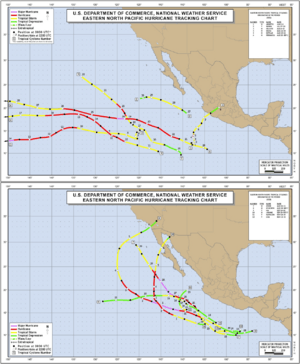1972 Pacific hurricane season facts for kids
 |
|
| Season summary map | |
| First storm formed | June 1, 1972 |
|---|---|
| Last storm dissipated | November 19, 1972 |
| Strongest storm | Celeste - 940 mb, 115 knots – |
| 14 | |
| Total fatalities | Unknown |
| Total damage | Unknown |
| seasons 1970, 1971, 1972, 1973, 1974 |
|
The 1972 Pacific hurricane season was a period when many powerful storms formed in the Pacific Ocean. This season officially began on May 15, 1972, in the eastern Pacific. It started a bit later, on June 1, 1972, in the central Pacific. The season ended on November 30, 1972. These dates are set to cover most of the time when tropical cyclones usually form in this part of the world.
Contents
What Happened in the 1972 Season?
This season had fewer storms than usual. There were a total of twelve tropical cyclones. A tropical cyclone is a spinning storm system that forms over warm ocean waters.
Types of Storms
Out of these twelve storms, four grew into tropical storms. A tropical storm has strong winds, but not as strong as a hurricane. Eight of the storms became hurricanes. Hurricanes are very powerful storms with even faster winds.
Major Hurricanes of 1972
Four of the hurricanes were called "major hurricanes." This means they reached Category 3 or higher on the Saffir–Simpson Hurricane Scale. This scale helps us measure how strong a hurricane is based on its wind speed. A Category 3 hurricane is very dangerous.
Storms in the Central Pacific
In the central Pacific Ocean, two tropical storms and two weaker tropical depressions formed. A tropical depression is the weakest type of tropical cyclone. One of these depressions and one of the storms moved across the International Date Line. When they crossed this line, they changed names and became known as typhoons.
Images for kids

